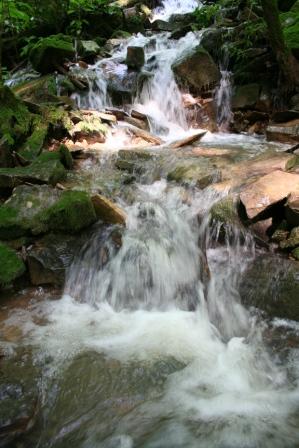Driving down I-10 from Florida to Louisiana a few weeks ago, I had hoped to see some of the colors of fall. What I actually saw was miles and miles of pine trees dotted with the occassional oranges, reds and golds of the native hardwoods. In many places this overabundance of pines is the result of an attempt to reforest areas after the native hardwoods were logged. Pines seem a natural choice for this effort as they grow faster than most hardwood species and return an area to a shaded forest environment much quicker. But at what price? The loss in diversity not only extends to the species of trees in the forest, but to the wildlife as well. Native wildlife depends on the many different types of trees for their homes and food and replanting every forest that is logged with pines will force some species to either adapt or leave.
As long as people continue to use paper and build wooden houses, logging will be a part of life, and a lucrative business. I personally witnessed the anguish of landowners in Mississippi who lost most or all of the trees on their property during hurricanes Katrina and Rita. Many of these people considered the opportunity to log the timber on their land as a retirement plan and most of that timber was pine. Approximately 50% of the forest in all the southern states is held by private land owners who intend to log within the next 10 years. In the next 40 years, another 10-15% of those forests will be lost to urban sprawl.
Can anything save the native hardwood forest? I believe the air-pruning process can do just that. By accelerating the growth rate and improving survival, the air-pruning process can produce a diversity of native hardwood species that mature in the same or better time as a traditional pine tree. The tremendous initial growth and early fruiting of EMI trees means that a logged area could be returned to a suitable habitat with shade, food and shelter for many wildlife species much quicker. In fact, many federal, state and local agencies (DOT, EPA, NRCS) recommend air-pruned trees because of their many habitat friendly qualities. I would love to see areas replanted with their native hardwood species and keep pine trees planted where they are native.
Tuesday, November 28, 2006
Friday, November 03, 2006
Revitalize Endangered Species
According to the 2006 IUCN Red List, there are over 7,000 species of tree that are threatened or endangered, 23 species are extinct in the wild and 79 species are gone forever.
One difficulty in revitalizing an endangered tree is a limited seed source. Seeds must be collected from the few trees that remain and used to grow seedlings in a controlled environment until they are strong enough to be planted in the wild. These young trees (depending on the species) can take up to 30 years before they begin to contribute to the seed source. Air-pruning can speed that process exponentially. All species on which air-pruning has been tested have begun to produce seeds within the first three years.
The following table shows the difference in the number of trees produced using air-pruning versus traditional methods. Several assumptions are made 1) there are 10 original trees to be used as seed source 2) one seed from every seed producing tree is collected, processed (only for air-pruned), germinated, grown and planted every year 3) traditionally grown trees require 30 years for seed production 4) air-pruned trees require 1 to 3 years for seed production and 5) there is 100% survival of all trees once planted.
One difficulty in revitalizing an endangered tree is a limited seed source. Seeds must be collected from the few trees that remain and used to grow seedlings in a controlled environment until they are strong enough to be planted in the wild. These young trees (depending on the species) can take up to 30 years before they begin to contribute to the seed source. Air-pruning can speed that process exponentially. All species on which air-pruning has been tested have begun to produce seeds within the first three years.
The following table shows the difference in the number of trees produced using air-pruning versus traditional methods. Several assumptions are made 1) there are 10 original trees to be used as seed source 2) one seed from every seed producing tree is collected, processed (only for air-pruned), germinated, grown and planted every year 3) traditionally grown trees require 30 years for seed production 4) air-pruned trees require 1 to 3 years for seed production and 5) there is 100% survival of all trees once planted.
Number | Number of Years the Planting Process is to be Repeated | Total Number of Trees at the End of the Time Period Using the air-pruning Process | Total Number of Trees at the End of the Time Period Using Traditional Methods |
10 | 5 | 62 | 50 |
10 | 10 | 445 | 100 |
10 | 15 | 3,150 | 150 |
10 | 20 | 22,328 | 200 |
10 | 25 | 158,287 | 250 |
10 | 30 | 1,122,108 | 300 |
By causing trees to produce seeds in 1 to 3 years instead of 30, air-pruning increases the seed source every year exponentially. With minimal effort, as air-pruning is very simple, any endangered tree species could be revitalized.
Subscribe to:
Posts (Atom)
